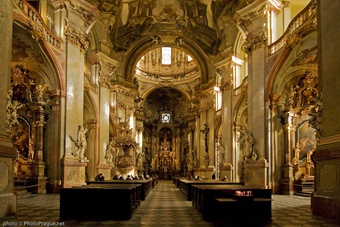
Baroque
Baroque architecture succeeds Renaissance architecture. The roots of Baroque originate in Papal Rome. Popes tried to emulate the Ceasars of the ancient world. If harmony, rationality characterise the Renaissance style, Baroque wants to impress and uses the monumental, dynamic optical effects, omnipresent illusion to do so. Prague Baroque architecture belongs to the most famous expressions of European Baroque.
In Prague, Baroque started after the Thirty Year War, direct result of the Counter-Reformation orders. The early Baroque style can be seen at the Old Town Jesuit College Klementinum, or on the St. Ignacio church on Charles Square in the New Town. It is the work of a renowned architect of the second half of the 17th century named Carlo Lurago.
The second wave of Baroque is directly connected to Rome. The main mediator of the new style is the archbishop architect Jean-Baptist Mathey, who was of French origin but represented pure Roman Baroque Classicism. His palace (Toskánský Palace), manor (Troja near Prague), as well as churches (church of St. Francis of Assisi near the Charles Bridge) fundamentally
influenced Prague architecture.
The so-called Radical Baroque, the roots of which originate in Rome (Francesco Borromini) and in Northern Italy (Guarino Guarini), is characterized by a dynamic movement and by a refined spatial composition. The main architect of Czech Radical Baroque architecture was Kryštof Dientzenhofer, who built Prague's cathedral of St. Mikuláš in the Lesser Town (nave of the church) and Prague's St. Margaret church in Břevnov.
Gothic Baroque is connected to Jan Blažej Santini-Aichl (facade and staircase of the church of St. Kajetán in the Lesser Town).
The peak and simultaneously the symbolic culmination of Baroque architecture in Prague came with the work of Kryštof Dientzenhofer's son named Kilián Ignác Dientzenhofer. He designed the dome and the belfry of the Lesser Town St. Mikuláš church. The power and persuadability of Dientzenhofer's architecture caused Prague and the entire Czech lands to be carried away by the Baroque "illusion" as late as in the second half of the 18th century, at a time when other European centres aimed towards the Neo-Classicism.











